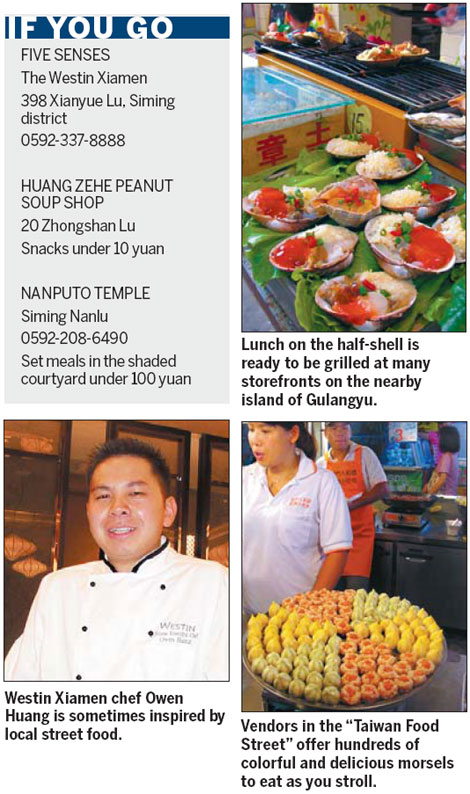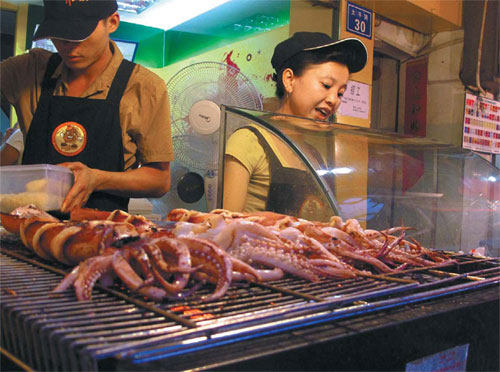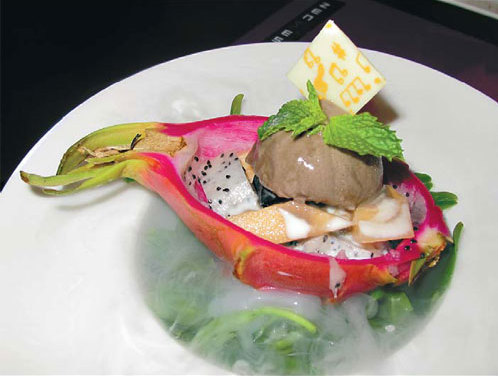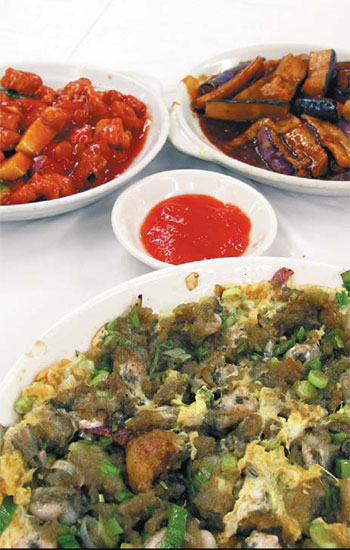Fujian food fantasies
Updated: 2012-09-02 07:57
By Mike Peters (China Daily)
|
||||||||
|
Squid on the grill is only one of the many seafood delights from Xiamen's street-food outlets. Photos by Mike Peters / China Daily |
|
The Westin Xiamen serves up a cool summer dessert in a dragon-fruit boat, delivering local ingredients in a sleek presentation. A scoop of ice cream made with Chinese herbs adds a licorice flavor. |
|
Xiamen's signature oyster omelets can be found at almost any local eatery in Fujian province. |
Mike Peters had never been to Xiamen before, but he's pretty sure he will be going back very often. Why? He lists all the delights that will draw him back to this coastal city in the south.
When I told friends I was about to make a trip to Xiamen, Fujian province, one and all were full of advice.
"You have to find the food street right away," one said. "It's amazing."
"Pies! You have to bring back some of the pies. They have great pies!" another said.
"The tea is quite special there, you will like it."
"You know they have great seafood, right?"
"You've got to find the worm jelly."
"There's a special kind of noodle"
It was beginning to seem like there was nothing to do in Xiamen but eat. But this may say more about my friends than about Xiamen. I did know about the great seafood. As a United States native who had grown up on the Texas Gulf Coast, I was already salivating at the prospect of "eating an oyster omelet every day".
Beijing-based chef Max Levy had earlier told me he'd made a food pilgrimage just to sample that delicacy. He says he ate four or five oyster omelets every day, but I was hoping to leave room for other delights, too. (Worm jelly? Hmmm.)
My own food odyssey started on the street, where I was spellbound by glistening red fruits sold kebab-style, three to a stick, each shaped like a tiny bell. These turned out to be rose apples - slightly tart, faintly perfumed and unexpectedly crunchy compared to other tropical fruits hawked on the island.
Since it was 33 C on that summer day, our group of visitors loved the watery freshness of this fruit as we strolled. Other street hawkers provided similar chances to munch and cool off, offering chunks from monster-size jackfruits, pineapple stuck on sticks and coconuts so full of sweet, milky juice I found it hard to resist grabbing another every time I finished one.
If you haven't fallen in love with street food elsewhere in China, Xiamen may be the place you finally succumb. On the nearby island of Gulangyu, we awoke to the smell of oysters on the half-shell, bubbling merrily on a grill with a big dollop of garlic. O breakfast divine ("Can I have two, please?")
Local cuisine isn't just about street food - it's right at home in upscale restaurants, too.
At a recent lunchtime visit to Five Senses, the elegant Cantonese restaurant at the brand-new Westin Xiamen, we found Huang Xinwen or Chef Owen hovering over a double-boiler of traditional soup. It's fragrant with Chinese herbs, chicken, duck and pork knuckle - they've all been simmering together for eight hours.
Satisfied with its progress, the Guangzhou native adds a carrot puree for a little thickness and a pleasing golden color, and leaves the pot to simmer another four hours.
"On the street, it's just soup," he says. "But here in a five-star hotel, the presentation and the quality is very important."
Huang, the hotel's executive Chinese chef, likes to pair the thick soup with a fresh catch of the day. Today, he'll be cutting a fillet of star grouper into an intricate rosette at the bottom of a tureen - and pouring the finished hot soup on top.
"That will cook the fish in about two minutes," he promises, but warns that this dish is not takeaway food. "It has to be eaten within three hours." (Our noses are twitching in anticipation: This dish won't be in front of us longer than about three minutes.)
That's not a Xiamen mama's way. Chef Owen says his goal is to include a few authentic tastes of Fujian province cuisine on the seasonally changing menu, but present it in a Western way.
Later, we took to the streets again, seeking the foods that have been the inspiration for such dishes.
Zhongshan Lu is the most famous lane of street food, with snacks including Shanghai dumplings (xiaolongbao), pork kebabs (zhurou chuan) and fried garlic (zhasuan), and a tiny street-side tea shop where you'll be served with clay teapots and cups that are decades old and impart a rich, unique flavor.
A hotspot is Huang Zehe Peanut Soup Shop, where the namesake specialty is worth standing in line for, which you may have to do.
We confess passing by the worm jelly, not wanting to risk losing tummy room when there were so many lovely oysters singing from the stalls. They came in a multitude of sizes, shell shapes and sauces, and we happy slurped our way toward the harbor without hitting a loser.
At dusk, we arrived at "Taiwan Food Street", just across from the ferry landing that takes you to Gulangyu, full of carnival-style, and brilliantly lit to invite casual strolling.
Farther afield are two excellent vegetarian restaurants, one at Nanputuo Temple, where you can take nourishment with resident monks, and Gongde Sucaiguan, not far away near Xiamen University.
On Gulangyu, there's a gaggle of small restaurants and stalls. We loved the dried goods - sweet and spicy beef, pork, and chicken jerky - at New World, where we lamented leaving behind a beautiful dried eel the size of a small surfboard.
New World is huge, and like smaller shops nearby, there are samples offered to help you decide which local goodies to take home as gifts. The island also has many teashops, particularly along Longtu Lu, where the Babycat Cafe and Mrs Zhang's Milktea Cafe offer the famous local Amoy handmade pie as well as teas.
After a day afoot pursuing seafood nibbles, it's a civilized way to wind down and enjoy the evening breeze.
Contact the writer at michaelpeters@chinadaily.com.cn.


 'Taken 2' grabs movie box office crown
'Taken 2' grabs movie box office crown
 Rihanna's 'Diamonds' tops UK pop chart
Rihanna's 'Diamonds' tops UK pop chart
 Fans get look at vintage Rolling Stones
Fans get look at vintage Rolling Stones
 Celebrities attend Power of Women event
Celebrities attend Power of Women event
 Ang Lee breaks 'every rule' to make unlikely new Life of Pi film
Ang Lee breaks 'every rule' to make unlikely new Life of Pi film
 Rihanna almost thrown out of nightclub
Rihanna almost thrown out of nightclub
 'Dark Knight' wins weekend box office
'Dark Knight' wins weekend box office
 'Total Recall' stars gather in Beverly Hills
'Total Recall' stars gather in Beverly Hills
Most Viewed
Editor's Picks

|

|

|

|

|

|
Today's Top News
Health new priority for quake zone
Xi meets US top military officer
Japan's boats driven out of Diaoyu
China mulls online shopping legislation
Bird flu death toll rises to 22
Putin appoints new ambassador to China
Japanese ships blocked from Diaoyu Islands
Inspired by Guan, more Chinese pick up golf
US Weekly

|

|










